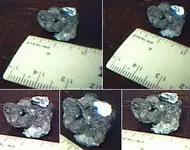ok.....heres what the book says about specific gravity testing;
GOLD AND SILVER TESTING FOR SPECIFIC GRAVITY
specific gravity is the ratio at which a material displaces water in relation to its bulk
this is an extremely delicate test.if it is not performed to exact standards,it will not give you good results.however,its accuracy when properly done is far superior to that of almost all other methods of testing.
testing by specific gravity is much safer than by testing minerals and metals with acid.
if you plan on doing much testing by this method,you should consider buying a specific gravity testing scale from one of the mineral and mining supply dealers.these scales range in price from $25 and up. the address of mineral and mining supply dealers can be found in the advertisements in your favorite rouckhound or treasure magazine.
if you do not plan on doing lots of testing for specific gravity,a home made unit will be close to that of a professional model if properly assembled and used.
we all know that lead sinks,while a cork floats in water. this tells us nothing beyond the fact that some items are heavier than others. this could just as easily been done by weighing each piece on an ordinary scale.
specific gravity goes much deeper than the mere differance between sink and float.it gives the weight of an object in relation to its exact size.as water fully encompasses an object when completely submerged, it therefore measures far better than rulers and calipers.
as every object of the same material gives the same specific gravity reading, regardless of its size,the specific gravity readings easily distinguish between gold,silver or alloys of these metals, as well as helping to identify precious gems such as diamonds, rubies, jade etc.
a specific gravity scale may be made from an ordinary pan scale calibrated in grams.
if it is calibrated higher than grams it will not work
in other words, you can not use an ordinary postal scale or anything like it. these pan scales calibrated in grams, can be obtained for less than $30 from the same mineral and mining supply dealers mentioned earlier.
HOW DOES IT WORK?
remove the pan from the scale, and tie a length of string,(thin nylon like fishing string is good), from the pan holder, at the extreme edge, as the scale faces you.the string should not be long enough to touch the desk, or whatever the scale is sitting on.a water glass about 3/4ths filled with water is then positioned beneath the string.(it may be necissary to rest the glass upon a lower platform in order to obtain the proper height).it will need to be positioned so that the item to be tested, when tied to the string or nylon line, and dropped into the water, is
fully submerged but does not touch the bottom or sides of the glass if it rests on the bottom of the glass or touches the sides, no matter how slight, the test will be spoiled.
as the object dangles in the glass of water, a reading is taken of the weight indicated on the gram scale indicator.
this is called:weight in water. this does not determine the specific gravity, but is the chief step in arriving at it. to get the specific gravity, the object must be weighed on the scale in the ordinary manner. be certain that the object is dry. this is called "air weight"
after you obtain the weight in water and the air weight, you subtract the weight in water from the weight in air.(the weight in air will always be the greater weight). you then divide the weight in air by the loss of weight in water,and you will have the objects specific gravity.
example weight in water 55.5 grams
weight in air 60.0 grams
subtract water weight from air weight 4.5 grams
divide loss of weight into air weight
4.5 divided into 60.0 equals 13.33
13.33 is the specific gravity.
the item in the example would be 14 karat gold.
depending on the accuracy of your scales, you will probably only be able to get very close approxamations rather than precise readings.
in the forgoing example we got a specific gravuty of 13.33 and called it 14k gold. this is the closest you may be able to get. however 14k gold is 13.55
specific gravity of metals:
tin......7.31
stainless steel ........7.80
iron.........7.81
brass.......8.52
german silver.......8.74
bronze.........8.82
copper........8.93
.925 silver........10.31
.999 pure silver......10.50
10k gold.........10.31
12k gold.........12.65
14k gold........13.55
18k gold............15.47
22k gold.........17.72
24k gold........19.32
platinum..........21.45
if you desire additional specific gravities, they can be found in your local library.
WHEW!!!!! i hope that makes sense to you!

good luck




 good luck
good luck


